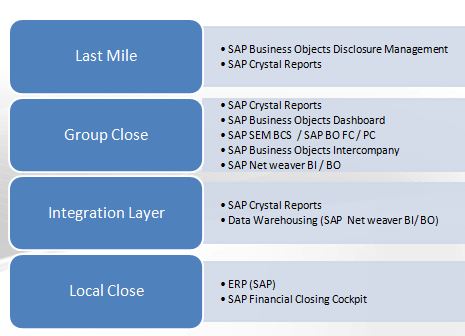
- SAP Community
- Products and Technology
- Additional Blogs by Members
- Financial Reporting Cycle Close - SAP's Product Su...
- Subscribe to RSS Feed
- Mark as New
- Mark as Read
- Bookmark
- Subscribe
- Printer Friendly Page
- Report Inappropriate Content
Many organizations are now working in the direction for high quality, well-managed and quick Financial Reporting Close cycle. This is becoming extremely important with need to adopt IFRS, SOX compliance and also mandated adoption of eXtensible Business Reporting Language.

In view of this, there is need to revisit the entire business process flow that impacts reporting cycle. Few years back and even now, emphasis was more towards business process flows such as procure to pay, order to cash etc, which involved multiple departments processes to be structured as one end to end process but information was available in one transactional system (ERP). But in case of financial reporting close cycle, it encompasses multiple layers of data across different tools / systems within the same Finance department but located at different geographies. So this now calls for streamlining of business process flow from ERP layer to Business Consolidation system and now even beyond that. This requires assessment of existing technology if they have independent accounting processes(Except for Local GAAP) and disintegrated systems.
Financial reporting close cycle is spread across three stages i.e., local close (ERP), group close (Consolidation) and last mile: Post close activities (Compliance framework including reporting / Publishing). I tried to summarize key activities / processes / functions within each cycle in the following diagram.

In the diagram, activities / processes shown in Local close, Group close and Last mile section are the areas that needs technology to support financial close. Activities indicated in the bottom in circles are the foundation for all the three closes and these are more related to business processes rather than technology.
Local Close
Looking at technology perspective and in specific to SAP, Local close was addressed by SAP ERP Financials including SAP Financial Closing cockpit.
Group Close
In the group close cycle, consolidating the data at data warehousing layer is a straight topic and does not require much of discussion though it is very important and herculean task to implement integration projects.Going to the next process i.e., Intercompany reconciliations. SAP provides a SAP Business Objects Intercompany tool as none of the consolidation tools in SAP portfolio handle transactional level eliminations (Invoice to Invoice).
In the area of Consolidation, SAP is very excited in this area with release of new versions of SAP Business Objects Financial Consolidation (earlier BO Cartesis) and SAP Business Objects Planning and Consolidation (earlier Outlook soft BPC, SAP BPC) based on Net weaver and Microsoft. These new versions come with IFRS starter kits. SAP is now aggressively marketing these new tools for customers. But as my knowledge goes, none of these tools including competitors (Oracle Hyperion and IBM Cognos Controller) match the best of Consolidation of Investments functionality as provided in SAP SEM BCS (SAP’s original consolidation tool). It is common for organizational change activities (transfer, divestiture, method change or liquidation) to take place in every reporting cycle. A tool / solution needs to handle these activities without much of manual postings. SAP SEM BCS has robust COI functionality to handle these activities (though it is not perfect world in BCS as well). SAP continues to invest in SAP SEM BCS by way of enhancements and maintenance strategy in line with SAP ERP. So at this point it is unclear if best of COI functionality of SAP SEM BCS will be integrated or will be built in SAP BO FC / PC in sometime future for existing customers to benefit from these new tools. In my opinion, customers using SEM BCS with need for best of COI functionality may have to continue using until SAP changes its approach / roadmap on SEM BCS. But there is one functionality that is lacking in SEM BCS i.e., dashboard functionality. The purpose here is to have a view on the status of consolidation tasks on quantitative basis for senior management. I assume SAP BusienssObjects Dashboard tool can be deployed to meet this requirement.
Last Mile
In the last mile – Post close activities, many of the organizations must have been handling this manually or possibly automated but with good amount of manual intervention. SAP has filled this gap with acquisition of Disclosure management solution from Cundus AG.This is now branded and launched in April 2011 as SAP Business Objects Disclosure Management. SAP is providing this with integration features with SAP products as well.
Following diagram sumamrizes SAP's product offering for Financial close cycle.

Group consolidation accounting team are not only expecting solutions which can streamiline particular processes, expectation is to have all these activities / functions from Post Local close sign off until publishing of statments as one process. This definetely calls for a BPM tool which can integrate all these processes in a single process flow. This might reduce the cycle time even further to what businesses are planning for. Would like to hear if any organisations have implemented this for a financial reporting cycle close.
My next Financial Reporting Cycle - Local Close covers on Local close cycle.
References:Accelerating the Financial Close CFOs' Insights into the Benefits of High-Quality Close - A report prepared by CFO Research Services in collaboration with SAP.
- SAP Ariba Supplier Management 2405 Release Key Innovations Preview in Spend Management Blogs by SAP
- New 1H 2024 SAP Successfactors Time (Tracking) Features in Human Capital Management Blogs by SAP
- Event report | Global SAP Financials Forum 2024, April 22-24 (WENFIT) in Financial Management Blogs by SAP
- Exploring Integration Options in SAP Datasphere with the focus on using SAP extractors - Part II in Technology Blogs by SAP
- Managing PFAS with SAP: Regulations and Business Challenges in Product Lifecycle Management Blogs by Members